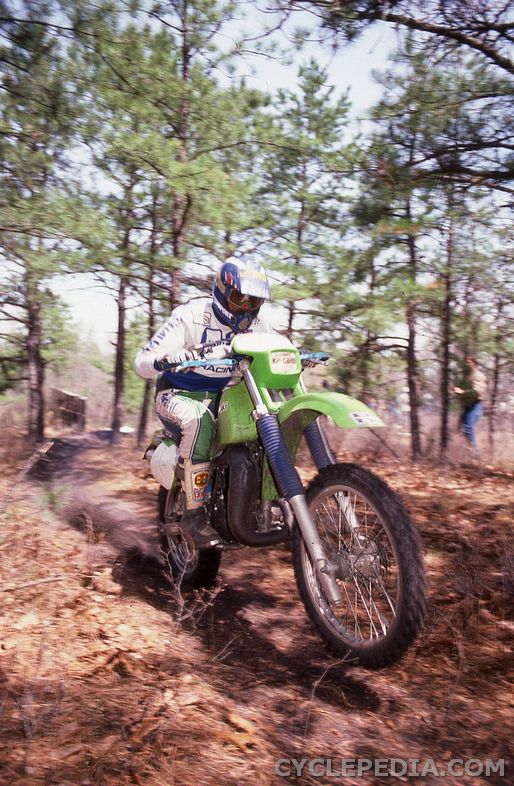
Kawasaki’s Jeff Fredette, long time champion of the KDX200, at a National Enduro in New Jersey in 1986. Photo by Paul Clipper / Trail Rider Magazine.KDX 200 220 Model History
1983 KDX200 A1
All new in 1983
198cc engine vs 173cc previous
Displacement gain is through longer stroke, same bore diameter as the 175
32mm Mikuni carb
New gear ratios in six-speed transmission
Seven plate clutch versus six plates for the KDX175
Chassis based on 1983 KX125; steel tubing, box-section aluminum swingarm
New single-strut Uni-Trak rear
Damping adjustable aluminum body shock
38mm Kayaba forks, 10.24 inches suspension travel (frt/rr)
Electronic odometer
Claimed dry weight of 207 pounds
1984 KDX200 A2
Available in green, or black frame with red plastic
Piston clearance changed to address seizure problem with A1 models
Fork drain plugs relocated to rear of sliders
Redesigned aluminum swingarm
KX125-style rear wheel with straight-pull spokes
Larger 3.2 gallon fuel tank
1985 KDX200 A3
New 34mm Mikuni “R” slide carburetor
1986 KDX200 C1
New KIPS powervalve
New front disc brake
New 43mm conventional forks
New rear shock
Taller first gear ratio
Larger flywheel and clutch assembly
Plastic hand guards on handlebars
New seat
1987 KDX200 C2
1988 KDX200 C3
Available as green, or silver frame with white plastic
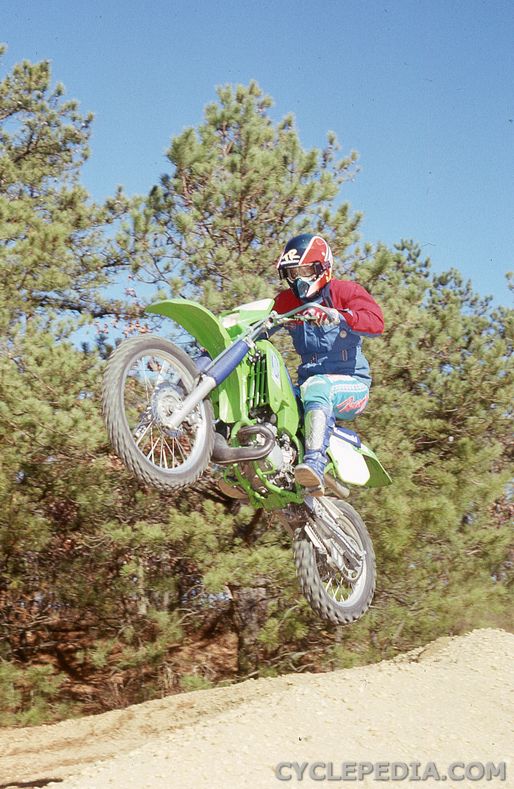
1989 KDX200 E1 – KDX Model History
Available as green, or blue frame with white plastic
First liquid-cooled KDX200 engine
New KX-style frame design
Rear disc brake
Heavier crank webs
Heavier clutch springs and more plates (seven steel/eight friction)
Quick access clutch cover
Dual wall expansion chamber for sound muffling
Aluminum spark arrestor/muffler
43mm forks with 20 compression damping adjustments
KX125-based shock with 16 compression and 16 rebound adjustments
Increased suspension travel—11.4 inches front, 11.8 inches rear
Swingarm offers quick release access for rear wheel
Front axle with pull handle
Larger airbox
Return to mechanical odometer from electronic odo of the past few years
47-tooth rear sprocket vs. 48-tooth previous
1990 KDX200 E2
Available as green, or blue frame with white plastic
1991 KDX200 E3
Available as green, or blue frame with white plastic
1992 KDX200 E4
1993 KDX200 E5
New 41mm upside down forks
1994 KDX200 E6
New 43mm inverted Kayaba forks
1995 KDX200 H1
First perimeter frame KDX200
43mm Kayaba non-USD cartridge forks
New engine mounts to combat vibration
KX-style powervalve
Higher cylinder compression
New crankshaft with stuffed webs and balancers
Larger radiators
Bigger clutch
Taller seat height
Smaller fuel tank (4/10 gal.)
1996 KDX200 H2
No changes for 1996
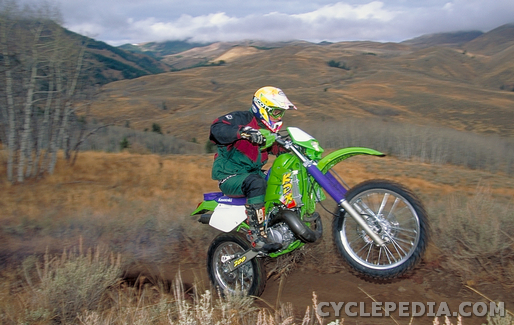
1997 KDX200 H3
1997 KDX220 A4
220 piston is 3mm larger than 200
220 carb is 2mm smaller, 33mm Keihin
O-ring chain
Heavier clutch springs
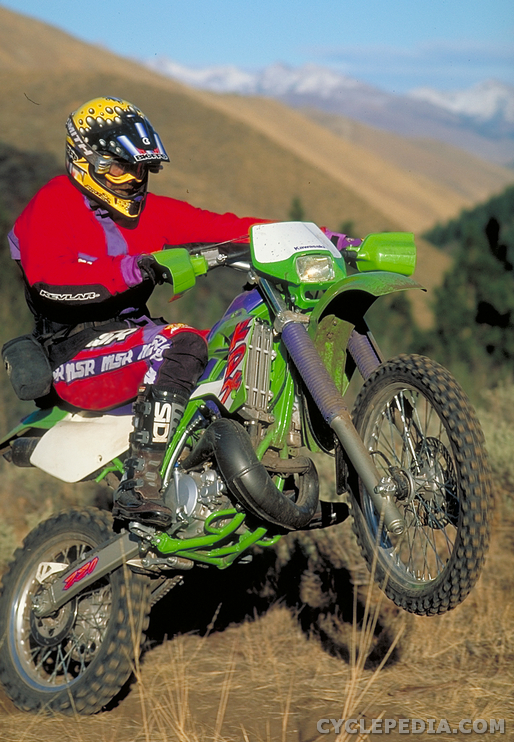
1997 KDX220 A4
1998 KDX200 H4, 1998 KDX220 A5
1999 KDX200 H5, 1999 KDX220 A6
2000 KDX200 H6, 2000 KDX220 A7
2001 KDX200 H7, 2001 KDX220 A8
2002 KDX200 H8, 2002 KDX220 A9
2003 KDX200 H9, 2003 KDX220 A10
2004 KDX200 H10, 2004 KDX220 A11
2005 KDX200 H11, 2005 KDX220 A12
Last year for KDX220
2006 KDX200 H12
Last year for KDX200
KDX200 Cyclepedia Staff Review
First a little KDX model history. In 1983, Kawasaki’s KDX175 evolved into the KDX200. It wasn’t a totally surprising move, since the AMA class displacement range for off-road racing had been changed to “126-200cc” and Honda had introduced the XR200 in 1979. Still, the additional 25cc of displacement made a huge difference in the 200cc two-stroke class. The KDX’s main competition, the PE175 Suzuki and the IT175 Yamaha, suffered for the lack of horsepower and the KDX200 emerged as the king of the class.
The KDX enjoyed a 198cc air-cooled, reed-valved engine that had been massaged by the members of the True Sport Racing team (see the KDX175 page on Cyclepedia). “I vaguely remember a KDX175,” joked True Sport team manager Jack Penton. “Our primary focus while racing in 1980 and ’81 was the development of the KDX200.” So yes, the bikes True Sport raced at all the nationals were 200cc prototypes. Primarily, the team had worked out porting and carburetion specifications by the time True Sport was disbanded in 1982, and had also calculated optimum transmission ratios for the KDX, among many other refinements.
“We got a kick out of the KDX’s progress after Tue Sport,” said Jack Penton. “We came up with so many refinements for that bike, and Kawasaki was smart. They didn’t release all of them at once to create a killer 1984 or ’85 KDX200. Instead they trickled them out for years, so the KDX always had new and appealing features. It was smart marketing.”
The first 200cc in 1983 was a fine bike, as a result of all this development. The 200cc engine delivered ample power off the bottom to make the bike easy to ride, but when the KDX “came on the pipe” it delivered a huge midrange hit that impressed testers from every magazine. “The best word is “violent,” Dirt Bike magazine said. “The power comes on so hard and fast that if the rider isn’t paying attention, the KDX will leap right out from under. When the front end comes back down the bike will rev out until it sounds as if it’s ready to explode, and will make power all the way to the top. Amazing!”
Less exciting, but possibly more important, is the improvement in the gear ratios in the 200 versus the KDX175. Jack Penton and the True Sport riders, along with engineering help from Tom Penton, tested and worked out gear ratio numbers that made the KDX virtually flawless as it was worked up through the gears. The combination of good, ridable power output as well as a sensible progression through the gears made the KDX hard to beat.
The KDX engine remained air-cooled until 1989. This may appear stone-age by present-day standards, but one big advantage remains from the lack of radiators, coolant pumps and plumbing: low weight. The early KDX200 claimed a dry weight of 207 pounds, quite light at the time. Jeff Fredette tells a story in March 1984 Dirt Bike magazine that, in the strict ISDE rules at the time (1983 Wales) he and Fritz Kadlec had to add 12 pounds of steel bars plus carry an extra 520 chain in the tool bag in order to meet the minimum weight requirements.
Looking back, handling and suspension on the KDX was a curious mix. Reading all the test reviews of the time, a common consensus comes out: The suspension components were nothing special on the early KDXs, but the chassis design carried the KDX to the top of the class with ease.
Frame design is as much of a black art as it is a science, and somehow Kawasaki managed to put together a chassis that appeared to be too long—in some cases two inches longer than the competition—creating a very stable platform for high-speed running. At the same time, the synergy between the fork angle and the Uni-Trak rear allowed the KDX to turn easily and precisely under any conditions.
And this included sub-par suspension units. The Kawasakis were notorious for coming from the factory with less than an ideal amount of oil in the forks, and they were also sprung for fairly lightweight riders. The stock forks were easy for an aggressive rider to bottom out, and so was the rear end, depending on rider weight. In spite of this, the KDX was a brilliant handling bike. Once the suspension was set up with the correct springs for the rider’s weight, and the fork oil level was set correctly, no one could dispute the handling superiority of the KDX.
Major Revisions – KDX Model History
The first three years of the KDX200 came with the model designation “A”—A1 through A3. Whenever there was a major revision to the line, the letter designation changed in a way that made little sense to the consumer. The next 200 in the series was the 1986 KDX200 C1; there was no “B1.”
The C Series (1986-1988)
The C1 KDX was an interesting machine. The engine remained air-cooled, but the finned cylinder grew a power valve, the common name for a variable-height exhaust port. The Kawasaki KIPS valve (Kawasaki Integrated Powervalve System) changed the timing of the exhaust port and also controlled two exhaust sub-ports. The net effect of the KIPS was to increase mid-range and low-end power slightly. Magazine testers of the time noted that the KDX200 C1 was “better suited for faster riders,” acknowledging the increase in power as another step forward as a racing bike rather than a beginner’s trail bike.
A very welcome improvement of the C1 was the addition of a disc front brake, relieving the drum brake problem by about 50 percent. Until the mid-80s most all enduro and trail bikes had drum brakes at both ends, well known to foul and lose effectiveness in mud and water, so the switch to a disc front was a significant improvement. It would be years yet before the KDX received a disc rear.
Major changes in the suspension also appeared on the C1, most significant was 43mm Kayaba conventional forks, increasing the flex-resistance (and therefore the steering accuracy) of the KDX. The rear shock was also improved, with a multi-adjustable aluminum bodied Kayaba unit that increased rear suspension travel to 11.4 inches. The fork travel was 10.6 inches.
Suspension action was still soft, keeping the KDX down in the enduro and trailbike category unless the owner invested in stiffer springs front and rear.
A larger clutch and a larger flywheel were built into the new KIPS-powered engine, and the gear ratio of first gear was raised to take advantage of the increased horsepower and greater flywheel affect.
The E Series (1989-1994)
The next major change came after three years of the “C” series KDX, and that was the KDX200 E1. In it, two of the most lusted-after changes were incorporated, and of course those two were a liquid-cooled engine and a rear disc brake. Finally the KDX was lifted to the level of the motocrossers of the time, and magazine testers asked the question, “Who could ever ask for more in an enduro bike?”
Predictably, the major changes on the ’89 KDX200 E1 caused a couple of headaches, in spite of all the joy. Both could be attributed to honest ignorance, one in the case of the factory, one in the case of the KDX rider.
First off, cooling the engine of a trail bike was a different matter than cooling a motocrosser. Enduro and trail bikes had to occasionally crawl through airless woods and rock gardens where slow-going was the only way to survive. That’s where the riders took them, and the new liquid-cooled KDX overheated dramatically. It would be a couple years before coolant flow was improved enough to reduce the troubles with boiling coolant, and in the mean time accessory companies were creating all sorts of special anti-freezes and cooling system fixes, not just for the KDX but for all water-cooled bikes of the time.
At the same time, riders were being asked to switch from barely-working drum brakes to disc brakes, and nearly all of them were used to dragging the rear brake all the while they were on the gas. The upshot of this was that the new rear disc overheated and wore pads away in no time. Tougher pads were developed, but the most important change, over time, is that riders finally adapted to the much more powerful disc brakes and stayed off of them except when they needed them.
Those were the two main complaints of the E-series KDX, but they were easily overshadowed with how well the new bike worked in the woods. The KDX suspension was still soft; sufficient for the woods but would bottom out in high speed sections. Handling was excellent, owing to the KX125 chassis, but for the first time the bike was reported as being a little “busy” in high speed rough riding. The short story was that the KDX was turning more into a race bike with every series change.
Special features of the E-series included a quick-change rear wheel, facilitated by a new axle slot in the swingarm, and a pull-handle on the front axle to make it easier to remove. A bigger clutch and a greater amount of crank mass counteracted the increase in horsepower, keeping the bike tractable. Suspension stroke was increased a quarter-inch on both ends, and a double-wall pipe helped quiet the bike, while creating protest that the pipe was too heavy.
A significant but often overlooked change on the E1 KDX was the switch to a 12 volt electrical system, versus the six-volt system that had been used since the KDX175. The airbox was now bigger and easier to get at; and in a surprise move, Kawasaki did away with the electronic odometer and went back to a mechanical one.
The H Series (1995-2006) – KDX Model History
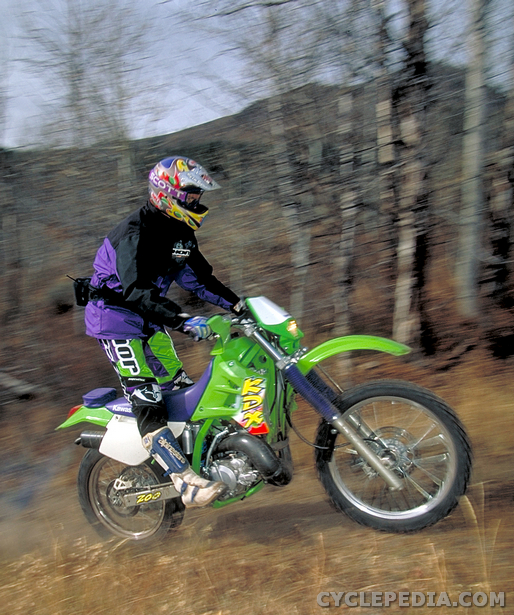
The final series of KDX machines were the “H” models, significant for the new KX-style perimeter frame. With the H series, Kawasaki finally moved the KDX into the realm of the race bike. There were so many changes on the H1 that it could be considered a completely new bike. 43mm conventional slider cartridge forks replaced the inverted forks from the year before, and of course the frame was completely new. The seat height was taller, thanks to the frame, and the fuel tank held slightly less. The liquid-cooled engine was completely new, with a new guillotine-style powervalve from the KX bikes, higher compression, a new crank and bigger clutch.
In spite of all these changes, the KDX still rode like a KDX, pleasing just about everyone. It still felt stable in the woods, still turned quickly in the trees. The seat height had been getting taller every year, but all bikes were taller and few complaints were heard. The new engine and its mounting configuration had finally reduced vibration to a distant memory on the KDX, and magazine reviewers wondered what Kawasaki could do to improve the 1995 KDX. The answer to that question was—very little. The KDX200 went on for another 12 years with very few changes. It was a 26 year run for Kawasaki’s most successful trail bike, ending with the bike being discontinued in 2006. The onslaught of the racing four-strokes and confusion over the future viability of two-stroke off road machines eroded sales of the KDX, and it was bumped to make room for the KLX series of four-strokes.
The KDX220
Kawasaki carted a group of worldwide offroad journalists to Idaho in 1997 to introduce their new baby—the KDX220. The setting was fabulous, no expenses were spared, and the riding was top-notch. The trouble was, the bike was confused. The 220 was a KDX200 with a 3mm larger bore and a 2mm smaller carburetor. Everyone assumed the 220 was created to compete with the 250cc competition on a more level playing field, but the 220 felt slower than the 200. Almost everyone in attendance preferred the 200 to the 220, but the magazine reviews of the time tried to be very kind to the KDX220.
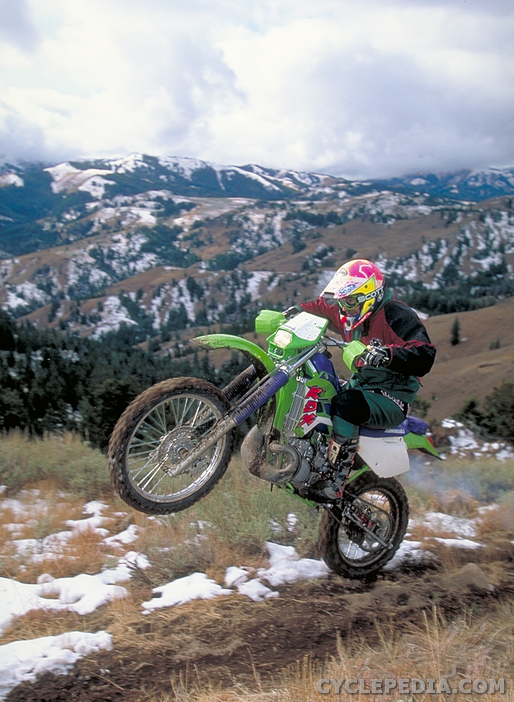
In the long run, it was determined that the 220 could actually be faster than the 200, but it needed a lot of work to get there. Careful porting, head work and boring out the carb was the key, along with an aftermarket pipe and silencer. The 220 sold well to racers and trail riders who wanted a “small 250,” but the existence of the 220 did not create a new market; instead it cut into the market established by the KDX200.
The 220 was definitely the unfinished racer, and in truth its presence on the showroom floors may have diluted sales of the KDX200 as well as its own (who would be pleased to buy a 20cc larger KDX and then find out it was slower than the 200?) and hastened the demise of both machines.
Popular Modifications
The non-cartridge forks of the KDX200 A and C series would universally benefit from setting the fork oil level properly, and using the right fork oil. 10w fork oil was recommended, KDX racer Jeff Fredette preferred 5w fork oil. Depending on rider weight, heavier springs were a welcome addition front and rear, as the KDX was sprung for a fairly light rider.
Careful cylinder porting and attention to compression ratio, carburetor jetting and all the facets integral to feeding fuel into the engine were guaranteed to bring more power out of the KDX engine. Jeff Fredette was (and remains) the sole expert along these lines. He is still quite capable of taking a “vintage” KDX and making sure the engine will humble most modern liquid-cooled bikes of any brand.
Without a doubt, the most popular modification to the KDX was the addition of an accessory expansion chamber, the most effective being any pipe purported to increase low-end power, the idea being to make the KDX even easier to ride quickly in tight woods and enduro situations. Accessory silencers also helped to improve power output, and also reduced overall weight, since the stock KDX silencer often weighed five pounds or more.
Kawasaki KDX200 Service Literature
1995 – 2006 Kawasaki KDX200 H Cyclepedia Online Manual
Kawasaki KDX200 E1 – E6 Cyclepedia Online Manual
Kawasaki KDX220 A Cyclepedia Online Manual
Kawasaki KDX200 Printed Service Manuals
External Links
Paul Clipper’s Bookstore: https://www.amazon.com/stores/author/B001KCOH8I
Fredette Racing Products: https://www.frpoffroad.com/



Leave a Reply
You must be logged in to post a comment.